Combining Pickering Emulsion Polymerization with Molecular Imprinting to Prepare Polymer Microspheres for Selective Solid-Phase Extraction of Malachite Green
Abstract
:1. Introduction
2. Experimental
2.1. Materials
2.2. Preparation of M-PMs Specifically Targeted to MG
2.3. Characterizations
2.4. Selective Adsorption of MG by M-PMs
2.5. Molecularly Imprinted Solid-Phase Extraction (MISPE) Column Test
2.6. Static Adsorption of MG
2.7. Adsorption Kinetics
2.8. Isothermal Adsorption
2.9. Adsorption Thermodynamics
3. Results and Discussion
3.1. Structural Characterizations and Analysis
3.2. Adsorption Measurements and Analysis
3.3. Evaluation of Adsorption Selectivity of M-PMs toward MG and the MISPE Column Applications
4. Conclusions
Supplementary Materials
Acknowledgments
Author Contributions
Conflicts of Interest
References
- Wu, L.; Lin, Z.Z.; Zhong, H.P.; Peng, A.H.; Chen, X.M.; Huang, Z.Y. Rapid detection of malachite green in fish based on CdTe quantum dots coated with molecularly imprinted silica. Food Chem. 2017, 229, 847–853. [Google Scholar] [CrossRef] [PubMed]
- Wu, L.; Lin, Z.-Z.; Zhong, H.-P.; Chen, X.-M.; Huang, Z.-Y. Rapid determination of malachite green in water and fish using a fluorescent probe based on CdTe quantum dots coated with molecularly imprinted polymer. Sens. Actuators B 2017, 239, 69–75. [Google Scholar] [CrossRef]
- Sasidharan Pillai, I.M.; Gupta, A.K. Electrochemical degradation of malachite green: Multivariate optimization, pathway identification and toxicity analysis. J. Environ. Health A 2016, 51, 1091–1099. [Google Scholar] [CrossRef] [PubMed]
- Aydin, F.; Yilmaz, E.; Soylak, M. A simple and novel deep eutectic solvent based ultrasound-assisted emulsification liquid phase microextraction method for malachite green in farmed and ornamental aquarium fish water samples. Microchem. J. 2017, 132, 280–285. [Google Scholar] [CrossRef]
- Zada, N.; Khan, I.; Saeed, K. Synthesis of multiwalled carbon nanotubes supported manganese and cobalt zinc oxides nanoparticles for the photodegradation of malachite green. Sep. Sci. Technol. 2017, 52, 1477–1485. [Google Scholar] [CrossRef]
- Barapatre, A.; Aadil, K.R.; Jha, H. Biodegradation of Malachite Green by the Ligninolytic Fungus Aspergillus flavus. Clean Soil Air Water 2017, 45, 1600045. [Google Scholar] [CrossRef]
- Nekouei, F.; Kargarzadeh, H.; Nekouei, S.; Tyagi, I.; Agarwal, S.; Kumar Gupta, V. Preparation of Nickel hydroxide nanoplates modified activated carbon for Malachite Green removal from solutions: Kinetic, thermodynamic, isotherm and antibacterial studies. Process Saf. Environ. Prot. 2016, 102, 85–97. [Google Scholar] [CrossRef]
- Qin, Y.; Zhang, J.; Li, Y.; Han, Y.; Zou, N.; Jiang, Y.; Shan, J.; Pan, C. Multiplug filtration cleanup method with multi-walled carbon nanotubes for the analysis of malachite green, diethylstilbestrol residues, and their metabolites in aquatic products by liquid chromatography–tandem mass spectrometry. Anal. Bioanal. Chem. 2016, 408, 5801–5809. [Google Scholar] [CrossRef] [PubMed]
- Ren, H.; Zhang, R.; Wang, Q.; Pan, H.; Wang, Y. Garlic root biomass as novel biosorbents for malachite green removal: Parameter optimization, process kinetics and toxicity test. Chem. Res. Chin. Univ. 2016, 32, 647–654. [Google Scholar] [CrossRef]
- Hu, H.-W.; Xin, J.H.; Hu, H. Highly Efficient Graphene-Based Ternary Composite Catalyst with Polydopamine Layer and Copper Nanoparticles. ChemPlusChem 2013, 78, 1483–1490. [Google Scholar] [CrossRef]
- Li, Y.-H.; Yang, T.; Qi, X.-L.; Qiao, Y.-W.; Deng, A.-P. Development of a group selective molecularly imprinted polymers based solid phase extraction of malachite green from fish water and fish feed samples. Anal. Chim. Acta 2008, 624, 317–325. [Google Scholar] [CrossRef] [PubMed]
- Lian, Z.; Wang, J. Molecularly imprinted polymer for selective extraction of malachite green from seawater and seafood coupled with high-performance liquid chromatographic determination. Mar. Pollut. Bull. 2012, 64, 2656–2662. [Google Scholar] [CrossRef] [PubMed]
- García-Rodríguez, O.; Bañuelos, J.A.; El-Ghenymy, A.; Godínez, L.A.; Brillas, E.; Rodríguez-Valadez, F.J. Use of a carbon felt–iron oxide air-diffusion cathode for the mineralization of Malachite Green dye by heterogeneous electro-Fenton and UVA photoelectro-Fenton processes. J. Electroanal. Chem. 2016, 767, 40–48. [Google Scholar] [CrossRef]
- Bañuelos, J.A.; García-Rodríguez, O.; El-Ghenymy, A.; Rodríguez-Valadez, F.J.; Godínez, L.A.; Brillas, E. Advanced oxidation treatment of malachite green dye using a low cost carbon-felt air-diffusion cathode. J. Environ. Chem. Eng. 2016, 4, 2066–2075. [Google Scholar] [CrossRef]
- Long, C.; Mai, Z.; Yang, Y.; Zhu, B.; Xu, X.; Lu, L.; Zou, X. Determination of multi-residue for malachite green, gentian violet and their metabolites in aquatic products by high-performance liquid chromatography coupled with molecularly imprinted solid-phase extraction. J. Chromatogr. A 2009, 1216, 2275–2281. [Google Scholar] [CrossRef] [PubMed]
- Skale, T.; Hohl, L.; Kraume, M.; Drews, A. Feasibility of w/o Pickering emulsion ultrafiltration. J. Membr. Sci. 2017, 535, 1–9. [Google Scholar] [CrossRef]
- Baillot, M.; Bentaleb, A.; Laurichesse, E.; Schmitt, V.; Backov, R. Triggering the Mechanical Release of Mineralized Pickering Emulsion-Based Capsules. Langmuir 2016, 32, 3880–3889. [Google Scholar] [CrossRef] [PubMed]
- Fujisawa, S.; Togawa, E.; Kuroda, K. Facile Route to Transparent, Strong, and Thermally Stable Nanocellulose/Polymer Nanocomposites from an Aqueous Pickering Emulsion. Biomacromolecules 2017, 18, 266–271. [Google Scholar] [CrossRef] [PubMed]
- Nishizawa, N.; Kawamura, A.; Kohri, M.; Nakamura, Y.; Fujii, S. Polydopamine Particle as a Particulate Emulsifier. Polymers 2016, 8, 62. [Google Scholar] [CrossRef]
- Korzhikov-Vlakh, V.; Krylova, M.; Sinitsyna, E.; Ivankova, E.; Averianov, I.; Tennikova, T. Hydrogel Layers on the Surface of Polyester-Based Materials for Improvement of Their Biointeractions and Controlled Release of Proteins. Polymers 2016, 8, 418. [Google Scholar] [CrossRef]
- Huang, L.; Li, M.; Wu, D.; Ma, X.; Wu, Z.; Xiang, S.; Chen, S. Molecularly Imprinted Nanofiber Film for Sensitive Sensing 2,4,6-Tribromophenol. Polymers 2016, 8, 222. [Google Scholar] [CrossRef]
- Cheng, W.; Fan, F.; Zhang, Y.; Pei, Z.; Wang, W.; Pei, Y. A Facile Approach for Fabrication of Core-Shell Magnetic Molecularly Imprinted Nanospheres towards Hypericin. Polymers 2017, 9, 135. [Google Scholar] [CrossRef]
- Shen, X.; Ye, L. Interfacial Molecular Imprinting in Nanoparticle-Stabilized Emulsions. Macromolecules 2011, 44, 5631–5637. [Google Scholar] [CrossRef] [PubMed]
- Gan, M.; Pan, J.; Zhang, Y.; Dai, X.; Yin, Y.; Qu, Q.; Yan, Y. Molecularly imprinted polymers derived from lignin-based Pickering emulsions and their selectively adsorption of lambda-cyhalothrin. Chem. Eng. J. 2014, 257, 317–327. [Google Scholar] [CrossRef]
- Zhu, W.; Ma, W.; Li, C.; Pan, J.; Dai, X.; Gan, M.; Qu, Q.; Zhang, Y. Magnetic molecularly imprinted microspheres via yeast stabilized Pickering emulsion polymerization for selective recognition of λ-cyhalothrin. Colloids Surf. A 2014, 453, 27–36. [Google Scholar] [CrossRef]
- Zhu, Y.; Jiang, D.; Sun, D.; Yan, Y.; Li, C. Fabrication of magnetic imprinted sorbents prepared by Pickering emulsion polymerization for adsorption of erythromycin from aqueous solution. J. Environ. Chem. Eng. 2016, 4, 3570–3579. [Google Scholar] [CrossRef]
- Zhu, W.; Ma, W.; Li, C.; Pan, J.; Dai, X. Well-designed multihollow magnetic imprinted microspheres based on cellulose nanocrystals (CNCs) stabilized Pickering double emulsion polymerization for selective adsorption of bifenthrin. Chem. Eng. J. 2015, 276, 249–260. [Google Scholar] [CrossRef]
- Yang, H.; Guo, T.-Y.; Zhou, D. Surface hydrophilic modification with well-defined glycopolymer for protein imprinting matrix. Int. J. Biol. Macromol. 2011, 48, 432–438. [Google Scholar] [CrossRef] [PubMed]
- Zhou, D.; Guo, T.; Yang, Y.; Zhang, Z. Surface imprinted macroporous film for high performance protein recognition in combination with quartz crystal microbalance. Sens. Actuators B 2011, 153, 96–102. [Google Scholar] [CrossRef]
- Liu, S.; Zhou, D.; Guo, T. Construction of a novel macroporous imprinted biosensor based on quartz crystal microbalance for ribonuclease Adetection. Biosens. Bioelectron. 2013, 42, 80–86. [Google Scholar] [CrossRef] [PubMed]
- Kuang, W.; Liu, Y.-N.; Huang, J. Phenol-modified hyper-cross-linked resins with almost all micro/mesopores and their adsorption to aniline. J. Colloid Interface Sci. 2017, 487, 31–37. [Google Scholar] [CrossRef] [PubMed]
- Jiang, X.; Huang, J. Adsorption of Rhodamine B on two novel polar-modified post-cross-linked resins: Equilibrium and kinetics. J. Colloid Interface Sci. 2016, 467, 230–238. [Google Scholar] [CrossRef] [PubMed]
- Hu, H.; Chang, M.; Zhang, M.; Wang, X.; Chen, D. A new insight into PAM/graphene-based adsorption of water-soluble aromatic pollutants. J. Mater. Sci. 2017, 52, 8650–8664. [Google Scholar] [CrossRef]
- Hu, H.; Chang, M.; Wang, X.; Chen, D. Cotton fabric-based facile solar photocatalytic purification of simulated real dye wastes. J. Mater. Sci. 2017, 52, 9922–9930. [Google Scholar] [CrossRef]
- Hu, H.; Xin, J.H.; Hu, H.; Wang, X.; Kong, Y. Metal-free graphene-based catalyst—Insight into the catalytic activity: A short review. Appl. Catal. A 2015, 492, 1–9. [Google Scholar] [CrossRef]
- Hu, H.; Xin, J.H.; Hu, H.; Wang, X.; Miao, D.; Liu, Y. Synthesis and stabilization of metal nanocatalysts for reduction reactions—A review. J. Mater. Chem. A 2015, 3, 11157–11182. [Google Scholar] [CrossRef]
- Hu, H.; Xin, J.H.; Hu, H.; Wang, X. Structural and mechanistic understanding of an active and durable graphene carbocatalyst for reduction of 4-nitrophenol at room temperature. Nano Res. 2015, 8, 3992–4006. [Google Scholar] [CrossRef]
- Hu, H.; Xin, J.H.; Hu, H.; Chan, A.; He, L. Glutaraldehyde–chitosan and poly (vinyl alcohol) blends, and fluorescence of their nano-silica composite films. Carbohydr. Polym. 2013, 91, 305–313. [Google Scholar] [CrossRef] [PubMed]
- Hu, H.; Xin, J.H.; Hu, H. PAM/graphene/Ag ternary hydrogel: Synthesis, characterization and catalytic application. J. Mater. Chem. A 2014, 2, 11319. [Google Scholar] [CrossRef]
- Hu, H.; Xin, J.; Hu, H.; Wang, X.; Lu, X. Organic Liquids-Responsive β-Cyclodextrin-Functionalized Graphene-Based Fluorescence Probe: Label-Free Selective Detection of Tetrahydrofuran. Molecules 2014, 19, 7459–7479. [Google Scholar] [CrossRef] [PubMed]
- Hu, H.; Wang, X.; Miao, D.; Wang, Y.; Lai, C.; Guo, Y.; Wang, W.; Xin, J.H.; Hu, H. A pH-mediated enhancement of the graphene carbocatalyst activity for the reduction of 4-nitrophenol. Chem. Commun. 2015, 51, 16699–16702. [Google Scholar] [CrossRef] [PubMed]
- Hu, H.; Wang, X.; Lee, K.I.; Ma, K.; Hu, H.; Xin, J.H. Graphene oxide-enhanced sol-gel transition sensitivity and drug release performance of an amphiphilic copolymer-based nanocomposite. Sci. Rep. 2016, 6, 31815. [Google Scholar] [CrossRef] [PubMed]
- Huo, J.; Hu, H.; Zhang, M.; Hu, X.; Chen, M.; Chen, D.; Liu, J.; Xiao, G.; Wang, Y.; Wen, Z. A mini review of the synthesis of poly-1,2,3-triazole-based functional materials. RSC Adv. 2017, 7, 2281–2287. [Google Scholar] [CrossRef]
- Mansa, R.F.; Sipaut, C.S.; Rahman, I.A.; Yusof, N.S.M.; Jafarzadeh, M. Preparation of glycine–modified silica nanoparticles for the adsorption of malachite green dye. J. Porous Mater. 2015, 23, 35–46. [Google Scholar] [CrossRef]
- Chabane, L.; Cheknane, B.; Zermane, F.; Bouras, O.; Baudu, M. Synthesis and characterization of reinforced hybrid porous beads: Application to the adsorption of malachite green in aqueous solution. Chem. Eng. Res. Des. 2017, 120, 291–302. [Google Scholar] [CrossRef]
- Roy, E.; Patra, S.; Tiwari, A.; Madhuri, R.; Sharma, P.K. Introduction of selectivity and specificity to graphene using an inimitable combination of molecular imprinting and nanotechnology. Biosens. Bioelectron. 2017, 89, 234–248. [Google Scholar] [CrossRef] [PubMed]
- Chen, L.; Wang, X.; Lu, W.; Wu, X.; Li, J. Molecular imprinting: Perspectives and applications. Chem. Soc. Rev. 2016, 45, 2137–2211. [Google Scholar] [CrossRef] [PubMed]
- Eser, A.; Aydemir, T.; Becerik, S.; Dinçer, A. Removal of erythrosine dye from aqueous solutions using magnetic chitosan with erythrosine as imprinted molecules. Desalin. Water Treat. 2016, 57, 17002–17010. [Google Scholar] [CrossRef]
- Qian, Y.; Wang, T.; Qiu, X.; Zhao, D.; Liu, D.; Deng, Y. Conductivity Enhancement of Poly(3,4-ethylenedioxythiophene)/Lignosulfonate Acid Complexes via Pickering Emulsion Polymerization. ACS Sustain. Chem. Eng. 2016, 4, 7193–7199. [Google Scholar] [CrossRef]
- Rafatullah, M.; Sulaiman, O.; Hashim, R.; Ahmad, A. Adsorption of methylene blue on low-cost adsorbents: A review. J. Hazard. Mater. 2010, 177, 70–80. [Google Scholar] [CrossRef] [PubMed]

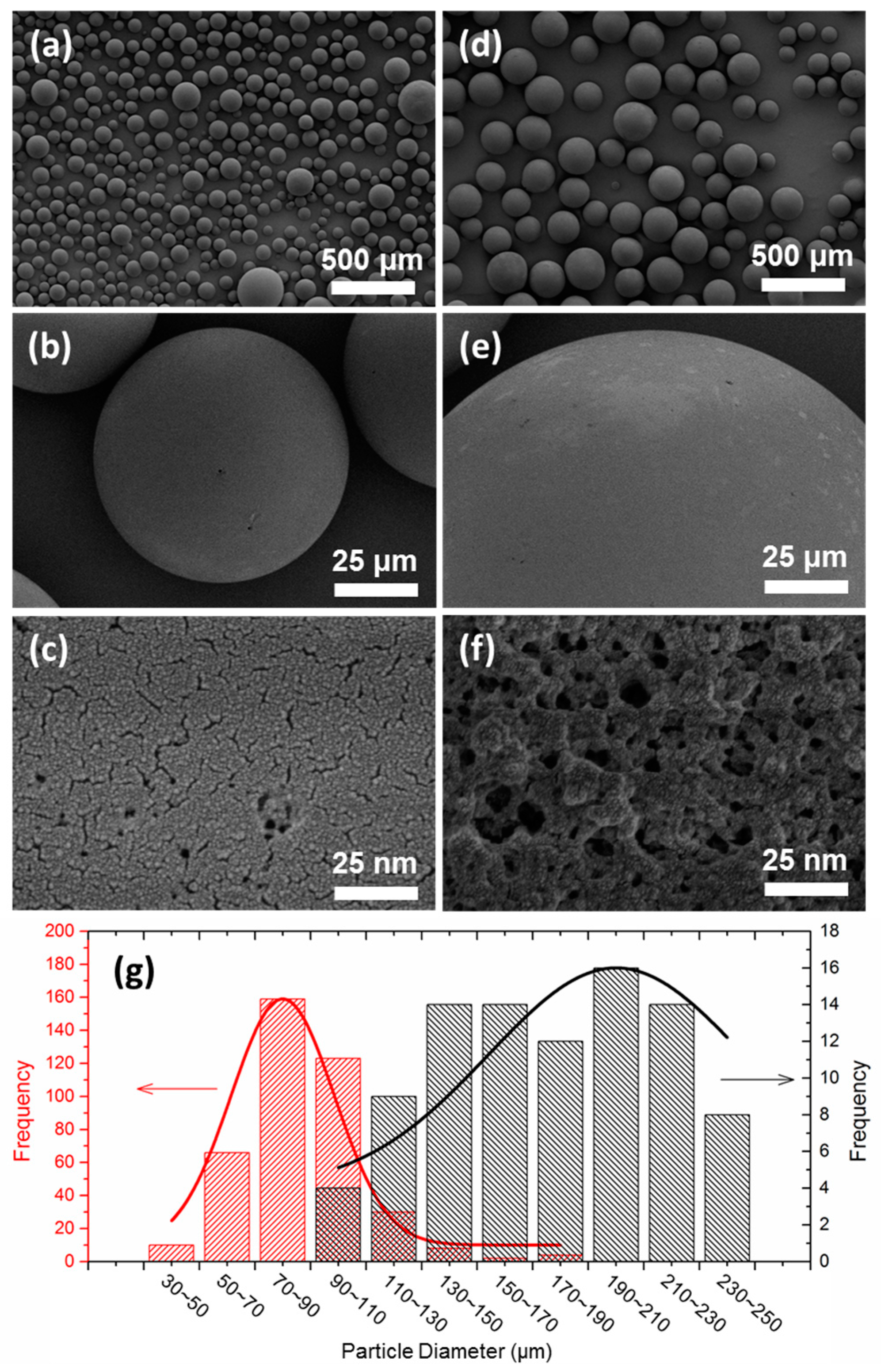

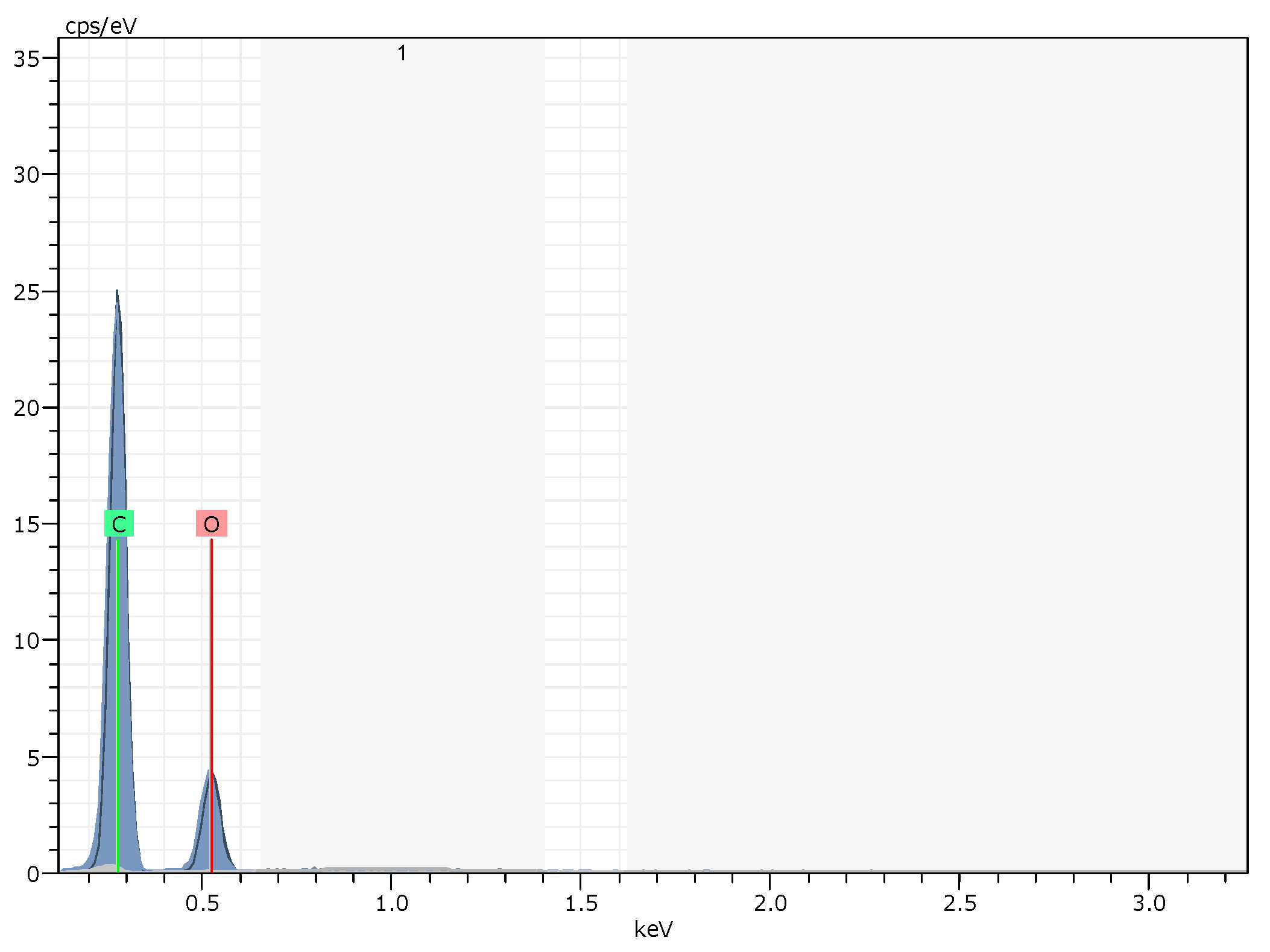
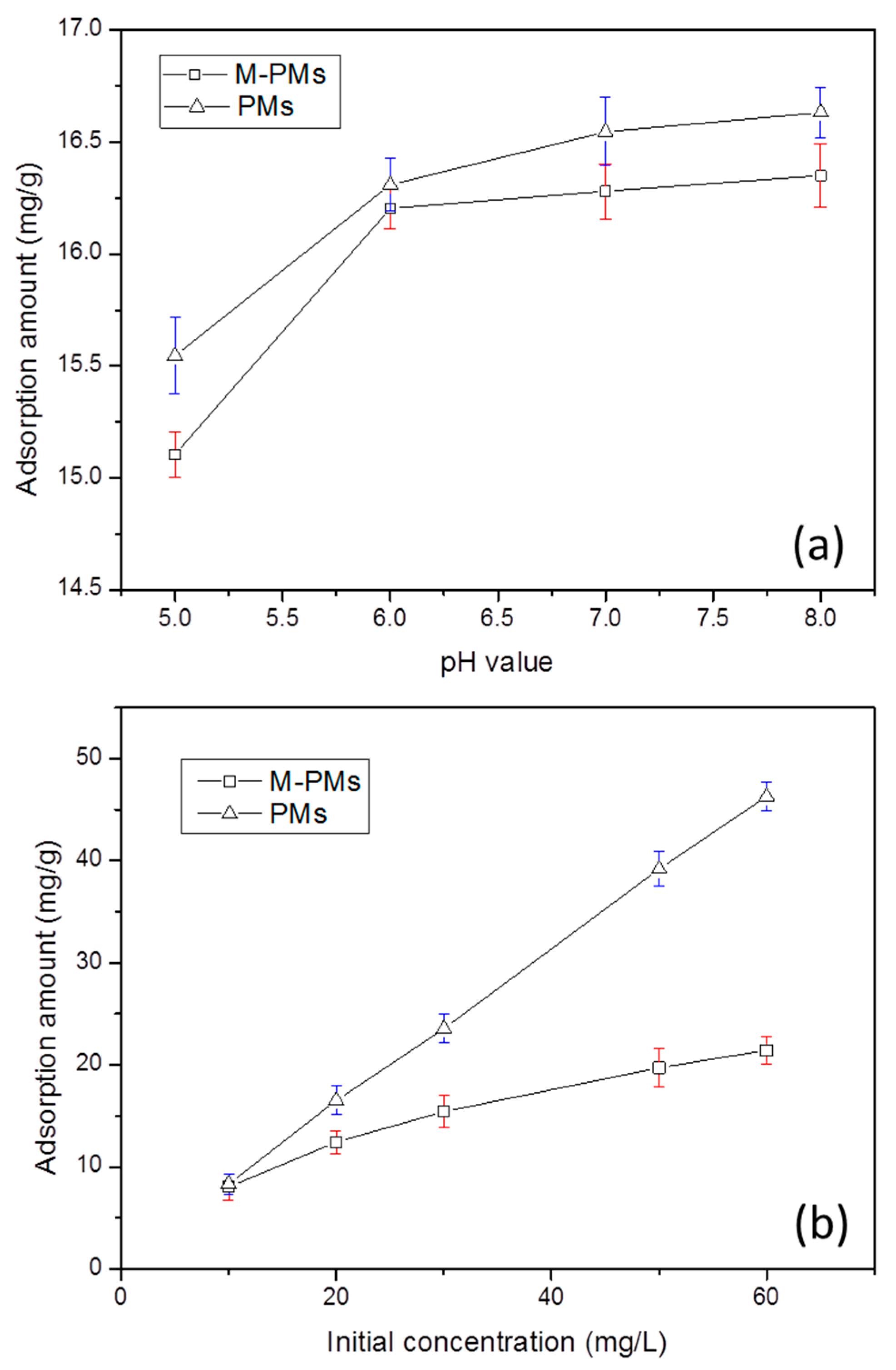
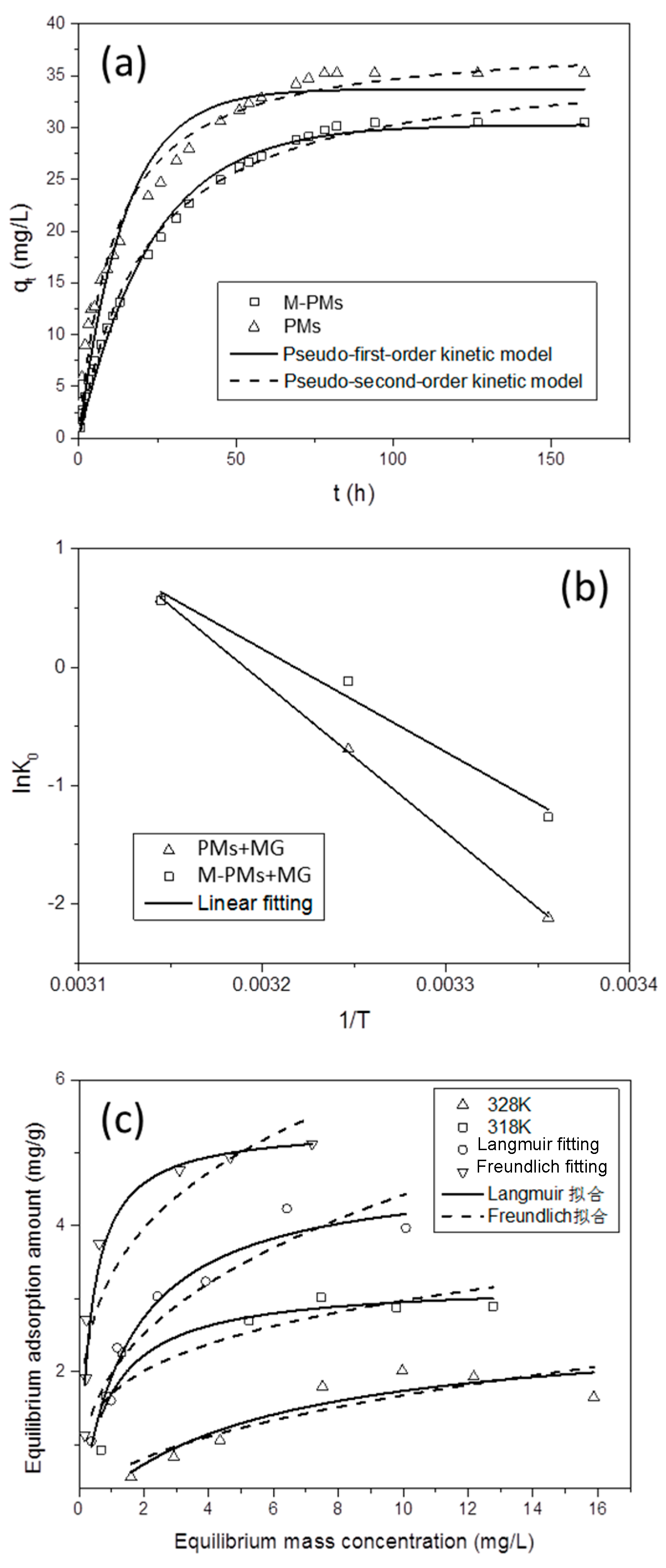
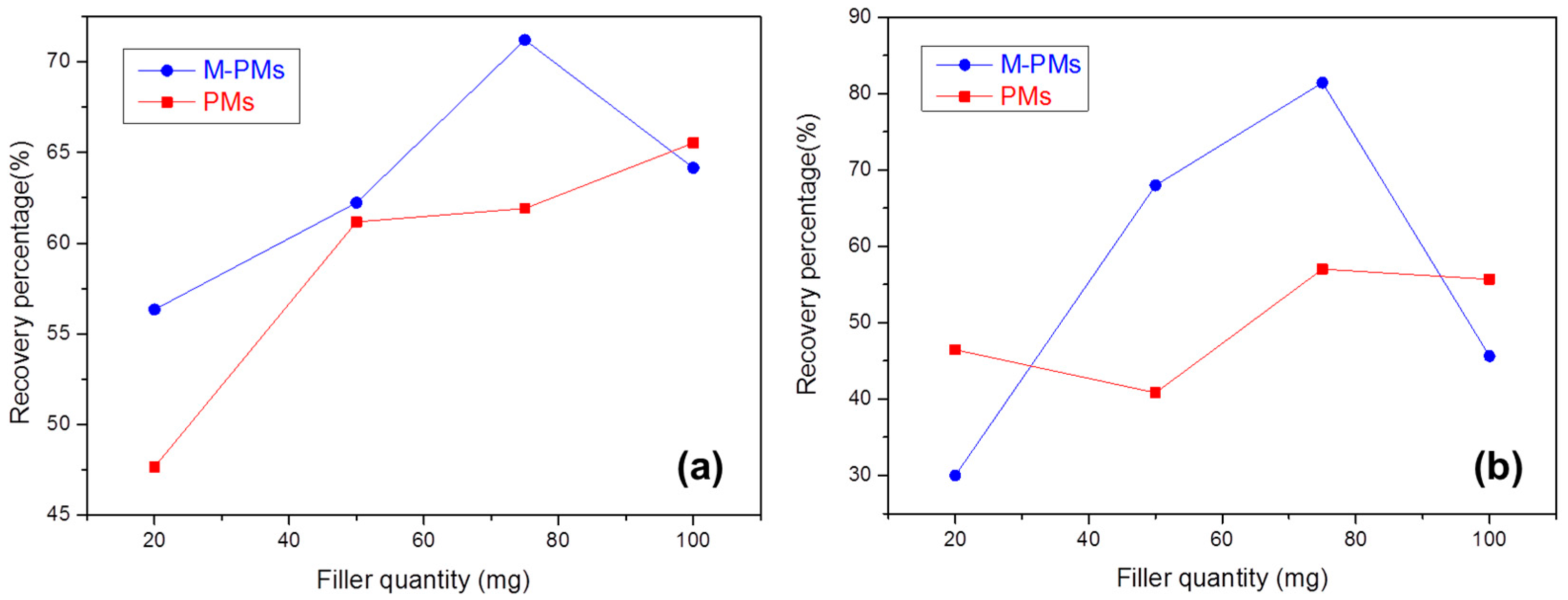
| Sample No. | Water Phase | Oil Phase | Result | ||||
|---|---|---|---|---|---|---|---|
| MG (mg) | EGDMA (mL) | MG (mg) | Leuco-MG (mg) | Styrene (mL) | Yield (%) | ||
| 1 | 0 | 1.73 | 0 | 0 | 0 | 93.1 | Large diameter with uniformity |
| 2 | 10 | 1.23 | 0 | 0 | 0.5 | 76.9 | Fine flocculent particles, with lower color depth after styrene addition |
| 3 | 0 | 1.73 | 10 | 0 | 0 | 91.9 | Uniform and fine particles |
| 4 | 10 | 1.23 | 0 | 0 | 0 | 83.3 | Uniform and fine particles |
| 5 | 0 | 1.23 | 0 | 5 | 0 | 81.1 | Small diameter with uniformity |
| 6 | 0 | 1.230 | 0 | 7.9 | 0 | 82.8 | Small diameter with uniformity |
| Heading | qe, exp/(mg·g−1) | Pseudo-First-Order Kinetic Models | Pseudo-Second-Order Kinetic Models | ||||
|---|---|---|---|---|---|---|---|
| q1e/(mg·g−1) | k1/(L·min−1) | R2 | q2e/(mg·g−1) | k2/(L·min−1) | R2 | ||
| PMs + MGM − PMs + MG | 35.25 | 33.71 | 1.16 × 10−3 | 0.9416 | 38.52 | 3.89 × 10−5 | 0.9757 |
| 30.47 | 30.25 | 7.14 × 10−4 | 0.9908 | 36.68 | 2.13 × 10−5 | 0.9942 | |
| ΔS°/(J/molK) | ΔH°/(KJ/molK) | R2 | ΔG° 300 K/(KJ/mol) | ΔG° 310 K/(KJ/mol) | ΔG° 320 K/(KJ/mol) | |
|---|---|---|---|---|---|---|
| PMs + MG | 338.21 | 106.01 | 0.999 | 5.24 | 1.77 | −1.51 |
| M-PMs + MG | 232.87 | 72.37 | 0.984 | 3.14 | 0.30 | −1.49 |
| T/K | Langmuir | Freundlich | ||||
|---|---|---|---|---|---|---|
| kl/(L/mg) | qm/(mg/g) | R2 | kf/(L/mg) | n | R2 | |
| 298 | 0.13 | 3.14 | 0.975 | 2.13 | 1.78 | 0.885 |
| 308 | 1.48 | 3.15 | 0.950 | 2.00 | 5.84 | 0.831 |
| 318 | 0.12 | 4.71 | 0.962 | 1.59 | 2.07 | 0.751 |
| 328 | 1.58 | 6.02 | 0.916 | 3.64 | 4.32 | 0.761 |
| Comparing Composition | M-PMs | PMs | K0 | ||||
|---|---|---|---|---|---|---|---|
| Ce (mg/L) | Kd (L/g) | k′ | Ce (mg/L) | Kd (L/g) | k′ | ||
| MG | 0.94 | 2.687 | 1.14 | 2.081 | |||
| RA | 2.69 | 0.404 | 6.6 | 2.85 | 0.335 | 6.2 | 1.07 |
| BY | 2.72 | 0.236 | 11.3 | 3.25 | 0.190 | 10.9 | 1.03 |
© 2017 by the authors. Licensee MDPI, Basel, Switzerland. This article is an open access article distributed under the terms and conditions of the Creative Commons Attribution (CC BY) license (http://creativecommons.org/licenses/by/4.0/).
Share and Cite
Liang, W.; Hu, H.; Guo, P.; Ma, Y.; Li, P.; Zheng, W.; Zhang, M. Combining Pickering Emulsion Polymerization with Molecular Imprinting to Prepare Polymer Microspheres for Selective Solid-Phase Extraction of Malachite Green. Polymers 2017, 9, 344. https://doi.org/10.3390/polym9080344
Liang W, Hu H, Guo P, Ma Y, Li P, Zheng W, Zhang M. Combining Pickering Emulsion Polymerization with Molecular Imprinting to Prepare Polymer Microspheres for Selective Solid-Phase Extraction of Malachite Green. Polymers. 2017; 9(8):344. https://doi.org/10.3390/polym9080344
Chicago/Turabian StyleLiang, Weixin, Huawen Hu, Pengran Guo, Yanfang Ma, Peiying Li, Wenrou Zheng, and Min Zhang. 2017. "Combining Pickering Emulsion Polymerization with Molecular Imprinting to Prepare Polymer Microspheres for Selective Solid-Phase Extraction of Malachite Green" Polymers 9, no. 8: 344. https://doi.org/10.3390/polym9080344





